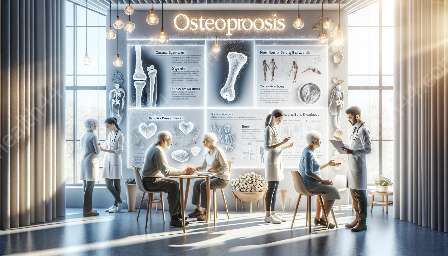Osteoporosis is a medical condition characterized by a decrease in bone density and strength, leading to an increased risk of fractures. It is a major health concern, particularly among older adults. Exercise plays a crucial role in preventing and managing osteoporosis, as it helps to strengthen bones and improve overall bone health. In this article, we will explore the relationship between exercise and osteoporosis, the best types of exercises, and their benefits for individuals with this health condition.
Understanding Osteoporosis
Osteoporosis is often referred to as a 'silent disease' because it progresses without any noticeable symptoms until a fracture occurs. The condition is more common in women, especially postmenopausal women, but it can affect men as well. Osteoporosis is characterized by low bone mass and microarchitectural deterioration of bone tissue, leading to bone fragility and an increased susceptibility to fractures, particularly in the hip, spine, and wrist.
Factors such as age, genetics, hormonal imbalances, and nutritional deficiencies can contribute to the development of osteoporosis. It is essential for individuals, particularly those at a higher risk, to take proactive steps to prevent and manage the condition, and exercise is one of the most effective strategies.
The Role of Exercise in Osteoporosis
Regular exercise is critically important for individuals with osteoporosis as it can help to improve bone density, strength, and overall physical function. Exercise exerts mechanical loads on bones, triggering a response that stimulates bone formation and remodeling. In addition to its direct effects on bone health, exercise can also enhance muscle strength, balance, and coordination, thereby reducing the risk of falls and fractures.
Weight-bearing and resistance exercises are particularly beneficial for individuals with osteoporosis. Weight-bearing exercises, such as walking, jogging, dancing, and stair climbing, subject the bones to impact and gravitational forces, which promotes bone development and maintenance. Resistance exercises involving weight lifting, elastic bands, or body weight can help to build muscle strength and support bone health.
Furthermore, flexibility and balance exercises, including stretching, yoga, and tai chi, are essential for improving posture, stability, and coordination, all of which contribute to reducing the risk of falls and fractures in individuals with osteoporosis.
Best Types of Exercises for Osteoporosis
When designing an exercise program for individuals with osteoporosis, it is crucial to include a combination of weight-bearing, resistance, flexibility, and balance exercises. The following are some of the best types of exercises for managing osteoporosis:
- Walking: Walking is a simple, low-impact weight-bearing exercise that provides numerous benefits for bone health. It is suitable for individuals of all ages and fitness levels and can be easily incorporated into daily routines.
- Resistance Training: Resistance exercises using free weights, weight machines, or resistance bands can help to build and maintain muscle strength, which is essential for supporting bone health.
- Dancing: Dancing, particularly styles that involve jumping and quick directional changes, is a fun and effective weight-bearing exercise for individuals with osteoporosis.
- Yoga: Yoga focuses on flexibility, balance, and strength, making it an excellent choice for individuals looking to improve overall physical function and reduce the risk of falls.
- Tai Chi: Tai chi is a gentle, low-impact exercise that emphasizes slow, flowing movements and is beneficial for enhancing balance and coordination.
- Stair Climbing: Climbing stairs provides a weight-bearing workout for the lower body, helping to strengthen bones and muscles.
Benefits of Exercise for Osteoporosis
Engaging in regular exercise offers numerous benefits for individuals with osteoporosis, including:
- Improved Bone Density: Weight-bearing and resistance exercises can help to maintain or increase bone density, reducing the risk of fractures.
- Enhanced Muscle Strength: Resistance exercises can improve muscle mass and strength, providing essential support for bones and helping to prevent falls.
- Better Posture and Balance: Flexibility and balance exercises can improve posture, stability, and coordination, reducing the risk of falls and fractures.
- Reduced Risk of Falls: Exercise can enhance balance and proprioception, reducing the likelihood of falls, particularly in older adults with osteoporosis.
- Enhanced Overall Physical Function: Regular physical activity can improve overall physical function, allowing individuals to maintain independence and quality of life.
Exercise Considerations for Individuals with Osteoporosis
While exercise is beneficial for managing osteoporosis, it is essential for individuals with this health condition to consider certain factors when engaging in physical activity:
- Consult with a Healthcare Professional: Before starting an exercise program, individuals with osteoporosis should consult with a healthcare professional to assess their current bone health, determine any limitations or precautions, and receive personalized exercise recommendations.
- Choose Safe and Appropriate Exercises: Individuals should select exercises that are safe and suitable for their current physical abilities and bone strength, avoiding high-impact activities that may increase the risk of fractures.
- Progress Gradually: It is important for individuals to start with low-intensity exercises and gradually increase the duration, frequency, and intensity over time to minimize the risk of injury.
- Focus on Proper Technique: Proper form and technique are crucial to prevent injuries, particularly when performing resistance exercises. Individuals should seek guidance from qualified fitness professionals to learn the correct exercise techniques.
- Include Balance and Flexibility Training: Integrating balance and flexibility exercises into the workout routine can help improve stability, reduce the risk of falls, and enhance physical function.
Conclusion
Exercise is a fundamental component of osteoporosis management and prevention, offering a wide range of benefits for bone health and overall physical function. By incorporating weight-bearing, resistance, flexibility, and balance exercises into their routine, individuals can strengthen bones, improve muscle strength, and reduce the risk of falls and fractures. It is important for individuals with osteoporosis to consult with healthcare professionals to develop an exercise program tailored to their specific needs and limitations. With the right approach, regular exercise can be a powerful ally in the fight against osteoporosis, promoting bone health and enhancing overall well-being.


